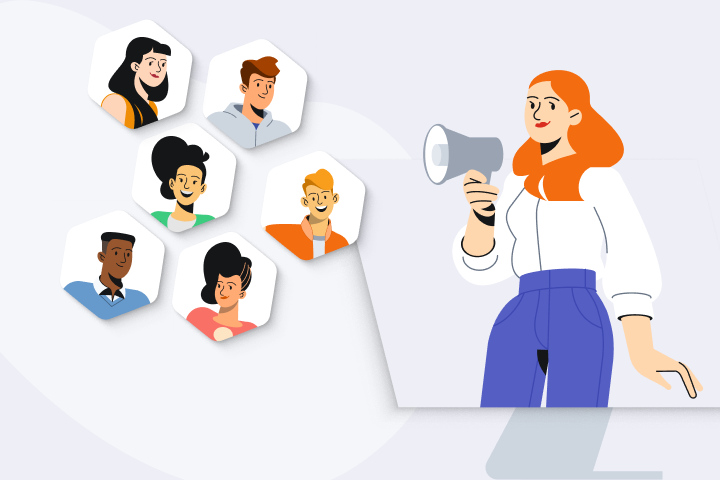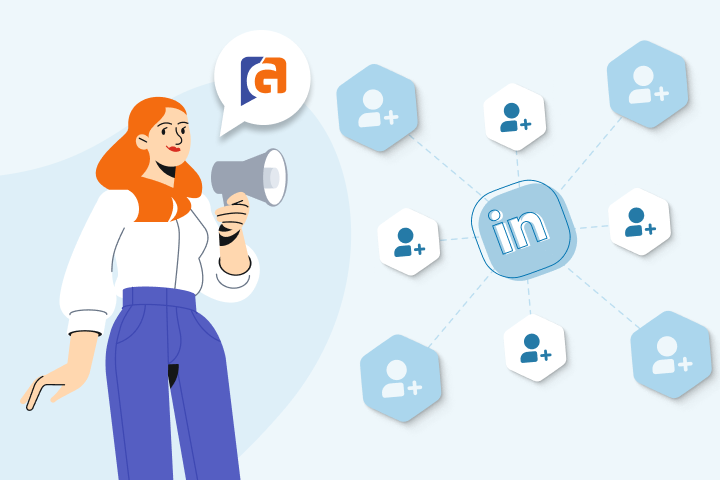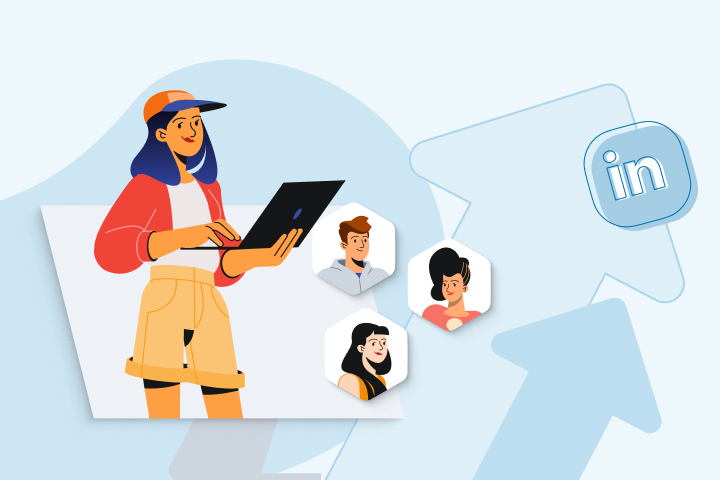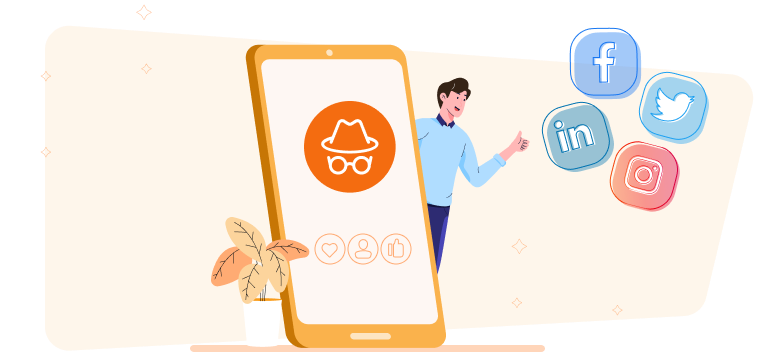How To Grow Your LinkedIn Network Strategically
Many of us think of LinkedIn as a living, breathing resume that showcases our skills, experience, and the people who vouch for us.
While that is true, it's also so much more.
Your LinkedIn network is a source of industry insights, a platform for thought leadership, a marketplace for your brand, a space for collaboration, and a bridge to career-defining opportunities. It’s also a primary source for recruiters to find candidates and for businesses to find B2B leads. So, naturally, strategically expanding your network leads to career growth and business development.
However, learning how to grow your LinkedIn network is not about collecting as many connections as possible. Rather, it’s about fostering genuine relationships with people who can help you achieve your goals (e.g., build brand awareness, generate leads, attract top talent, etc.).
Building a strong LinkedIn network takes time and effort, but the rewards are substantial. This thorough guide shows you how to expand your LinkedIn connections and achieve your career goals.
Let’s get started.
Optimizing Your LinkedIn Profile
Your LinkedIn profile is your digital business card and often the first impression you make with potential connections.
By optimizing it, you create the foundation for growing your network. A well-crafted profile attracts more connection requests and increases the chances those requests will be accepted.
Here are some tips to make your LinkedIn profile page stand out.
Complete Your Profile Information
A complete profile is more likely to catch the eye of potential connections and help them get a sense of who you are —- increasing their chances of wanting to connect.
Most people don’t achieve the “All-star” status for their profile despite LinkedIn reporting that All-star profiles get more refined connection suggestions, relevant feed updates, and views.
To reach that coveted All-star profile status, key areas to focus on include:
-
Work Experience.
-
Education.
-
Skills.
-
Volunteer Experience.
-
Accomplishments.
But, don't just list your roles, instead:
-
Use concrete examples to describe your achievements and the impact you've made in each position.
-
Show, don’t tell. Rather than saying you build, say, “competitive employee advocacy programs,” show us how you did it. “Leveraging GaggleAMP with 150 of our most socially aware employees, we drove $25 million in reach, 25,000 additional clicks to our content, and over 13,500 engagements on our content. This motion resulted in paying for itself and offsetting our paid social media spend by 40%.”
-
Update your profile regularly with new projects, skills, or certifications. A stagnant profile can make you appear disengaged or out-of-date.
Craft a Compelling Headline and About Summary
Your Headline and About summary are your elevator pitch. They should quickly and concisely convey who you are, what you do, and what value you bring. To increase your visibility, include keywords that your target audience is searching for.
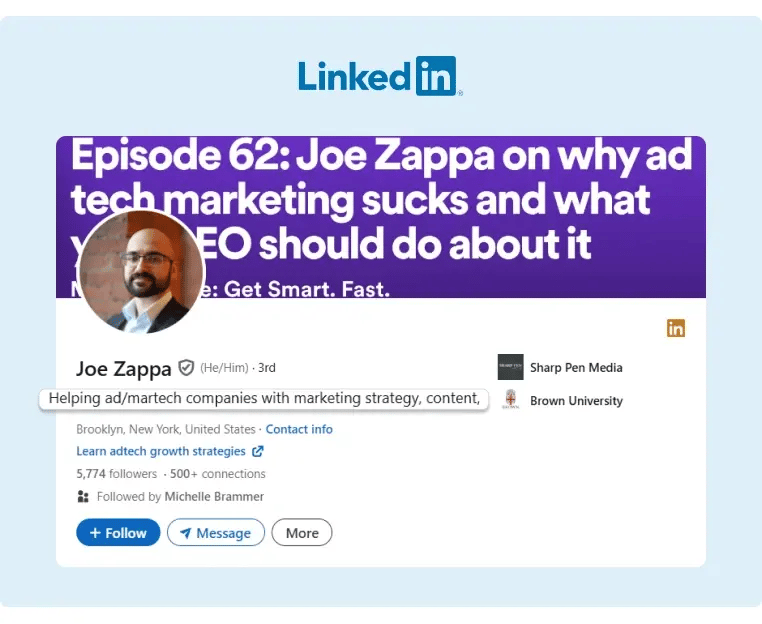
Since your Headline directly appears in search results and connection requests, describe more than just your job title to convert searches into clicks. You have only a few seconds to capture someone's attention.
Next, the About section is where you give a summary of your professional story. Here you can connect with your audience authentically while including all of the key elevator pitch points (e.g., who you are, what you do, why it matters).
Mark Jung, a LinkedIn power contributor and LinkedIn expert, recommends short and impactful sentences in the About section. A common tactic to keep them reading is to hook them at the beginning. Jung regularly uses the “F-shaped” reading pattern in his About section to keep content scannable. He also leverages short and impactful sentences to keep readers engaged.

Source: Mark P. Jung
Use a Professional Profile Picture
Simply having a profile picture makes your profile 14x more likely to be viewed by others. But, having a professional picture will give your LinkedIn profile an even bigger boost.
Professional photos are:
-
Recent and recognizable.
-
Well-lit and clear.
-
Feature what you’d wear to work (e.g., business casual attire).
-
Show you alone (no group shots).
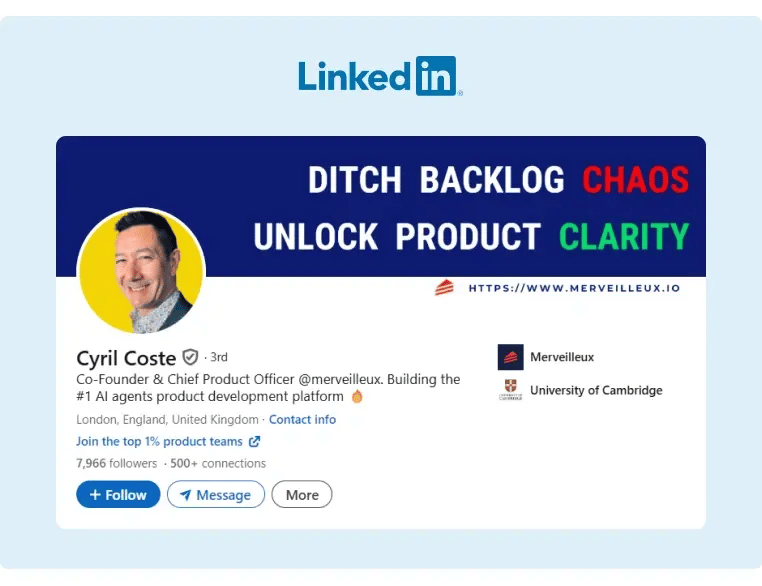
Source: Cyril Coste
Your face should also fill about 60% of the frame. While your facial expression is up to you —- you might feel a serious business warrants a more serious expression —- a study of 800 profile pictures found that people view you as more likable, competent, and influential if you’re smiling in your picture. But, don’t force yourself if smiling isn’t your style (e.g., entrepreneur Victoria Beckham).
Showcase Your Unique Value
Use the Featured section to highlight your best work. You can include articles you’ve written, projects you’ve completed, presentations you’ve given, or media appearances.

Source: Nati Zaretsky
This section gives visitors a quick, visual representation of your professional achievements and expertise.
Integrate Your Website or Portfolio
Linking to your website, portfolio, or relevant projects makes it easy for people to learn more about you.

Source: Sam Jacobs
This cross-platform integration helps provide more information for those interested, showcases work that couldn’t be included in the profile, and builds credibility.
Leveraging LinkedIn Features
As you begin to look for people on LinkedIn, you might have trouble finding the right ones. Luckily, LinkedIn offers a range of powerful tools to help connect with people who matter most.
Now let’s take a look at how to grow your network on LinkedIn by using these features effectively.
1. Advanced Search Filters
LinkedIn's search function is more than just a name-lookup tool. It's a sophisticated system that pinpoints connections based on specific criteria.
To use it effectively:
-
Narrow your search by industry, company, job title, or location.
-
Use boolean operators (AND, OR, NOT) to refine results.
-
Save your searches to revisit later.
If you're targeting a specific company, try searching for second-degree connections who work there. These are people connected to your existing network, which makes introductions easier.
2. Creator Mode
Switching to Creator Mode can increase your visibility on the platform. It's particularly useful if you regularly share content or insights.
Benefits of Creator Mode:
-
Your content gets more exposure in feeds.
-
You gain access to additional analytics.
-
The "Connect" button on your profile changes to "Follow".
If you meet the access criteria, you can even access sharing tools such as LinkedIn Live, Audio Events, and Newsletter.
Remember, Creator Mode works best when you consistently produce and share valuable content —- so only use it if appropriate.
3. Connection Suggestions
LinkedIn's algorithm is pretty smart. It suggests potential connections based on your profile, activity, and interests.
While not every suggestion will be a perfect fit, it's a good starting point for discovering new people in your field.
To make the most of this feature:
-
Regularly check the "My Network" tab for suggestions.
-
Look for mutual connections and shared interests.
-
Don't just connect —- engage with their content first.
Building Your Network
Growing your LinkedIn network isn't just about adding connections — it's about making meaningful connections. At the same time, you need to think about your goals and find relevant opportunities.
Here's how to approach network building strategically and authentically.
Connect With Colleagues, Alumni, and Thought Leaders
First things first: start with people you know. Current and former colleagues, classmates, and industry peers are natural connections. Similarly, alumni networks can connect you with people who are more willing to help you out, based on institutional affiliation, despite not knowing them.
Too often many of us forget the extent and strength of these connections.
Additional effective tips for how to get more connections on LinkedIn:
-
Sync your email contacts with LinkedIn to find existing connections.
-
Join your school's alumni group on LinkedIn.
-
Follow thought leaders and peers in your industry. Engage with their content before connecting.
Personalize Your Connection Requests
Generic connection requests are often ignored. Many automated requests also end up going to irrelevant profiles. Instead, take the time to craft a personal message that explains why you want to connect.
Elements of a good connection request:
-
Mention how you found them (mutual connection, shared group, etc.).
-
Point out something you have in common.
-
Explain why you want to connect.
-
Keep it brief —- you have a 300-character limit.

LinkedIn InMail: A Double-Edged Sword
A connection request can only be sent with a short note. LinkedIn InMail, however, is a premium feature that allows you to send direct messages to LinkedIn members you're not connected with.
While this is a powerful tool for network building, it needs to be used strategically otherwise it can end up backfiring.
A well-composed and relevant InMail message helps reach decision-makers or thought leaders who might not accept traditional connection requests. However, some users perceive InMail messages as spammy or intrusive.
When using InMail, follow these best practices:
-
Much like a connection request, personalize each message. Many InMail messages are dismissed because they’re generic templates.
-
Have a clear and specific reason to connect. This makes it easier and quicker for the recipient to reply (if they’re interested).
-
Shorter InMails get more responses, so keep it concise and respectful of the recipient's time.

Source: Tribal Impact
Engage With Your Existing Network
Building your network isn't just about making new connections —- it's also about strengthening existing ones.
Think of it like inbound marketing: this might lead the right people to send you connect requests rather than the other way around.
How to grow your network on LinkedIn by active engagement:
-
Comment on and share posts from your connections.
-
Congratulate connections on new jobs or work anniversaries.
-
Officially endorse the skills of colleagues you've worked with.
Second-degree connections — those connected to your existing network — are also valuable targets for expansion. They're easier to reach and more likely to accept your request.
To leverage second-degree connections:
-
Use LinkedIn's "People You May Know" feature.
-
Look at who's commenting on posts from your connections.
-
Ask for introductions when appropriate.
Follow Up on In-Person Networking
Met someone at a conference or industry event? Follow up on LinkedIn within 48 hours while the interaction is still fresh.
Engaging With Communities
Social media is all about community, isn’t it? So, tap into it!
Actively participating in relevant communities, groups, and discussions is a surefire way to show your value and connect with like-minded professionals and industry leaders.
Join Relevant Communities and Groups
LinkedIn hosts thousands of professional groups across various industries and interests. Joining the right ones can unlock great networking opportunities.
Here’s how to find and join the right groups:
-
Use LinkedIn's search function to find groups in your industry.
-
Check which groups your connections are in.
-
Look for alumni groups from your schools or former employers.
-
Aim for a mix of large, active groups and smaller, niche communities.
It's better to be active in a few relevant groups than to join dozens that you’ll never engage with. Here, quality trumps quantity.
Actively Participate in Discussions
Once you've joined some groups, don't be a silent observer. Engage in discussions to get noticed. It might feel vulnerable to put yourself out there, but the more you do it, the easier it gets.
Tips for effective participation:
-
Share your expertise by answering questions.
-
Be genuinely curious, ask thoughtful questions, and start discussions.
-
Share relevant articles or insights (without self-promotion).
-
Comment on posts with meaningful additions to the conversation.
-
Offer congratulations on their achievements.
-
When possible, connect them to relevant opportunities.
Consistent, valuable contributions will help people remember you and potentially even look up to you.
Network With Group Members
After you’ve joined a group and established your presence, it’s time to connect with other professionals one-on-one.
Surefire strategies for networking within groups:
-
Reach out to members who consistently provide valuable insights.
-
Use shared group membership as a conversation starter when sending connection requests.
-
Offer to collaborate on projects or content with fellow group members.
Leverage LinkedIn Events
LinkedIn Events is a powerful feature for networking, whether you're attending or hosting.

Source: WINSDay Event by Jessie Lizak
Here are some tips to maximize using LinkedIn Events:
For attendees:
-
RSVP to relevant events in your industry.
-
Engage with other attendees before, during, and after the event.
-
Follow up with new connections you make during the event.
For hosts:
-
Create events about relevant industry topics or your expertise.
-
Invest in the event’s presentation, invite your network, and encourage them to invite others.
-
Encourage engagement, participation, and questions from the audience.
-
Be well-prepared when hosting an event. This is a make-or-break opportunity to connect with potential clients or collaborators.
By actively engaging in LinkedIn communities and events, you’ll grow your LinkedIn network organically.
Creating and Sharing Content
We’ve talked about what you can do to get noticed, have people accept your connection requests, and provide value to your connections.
A common thread across all of these previous strategies is creating and sharing content. It builds your personal brand, demonstrates your expertise, and gives your connections reasons to engage with you.
Here are five tactics to create a LinkedIn content strategy that drives engagement:
1. Post Regularly To Maintain Visibility
Consistency is key in content creation. Regular posting keeps you top-of-mind with your network. VP of Sales at Jane Technologies, Inc. Brian Geddes consistently posts on a regular basis.

Source: Brian Geddes
Posting strategy:
-
Aim for two to three posts per week.
-
Use LinkedIn's analytics to find the best times to post for your audience.
-
Mix up your content types (e.g., text, images, videos, articles).
2. Write and Publish Quality Articles
Writing original content shows a strong level of depth and understanding of your field. As you continue to post insightful articles, other professionals pay more attention.
Great content convinces people that you are a valuable connection.
Article writing tips:
-
Choose narrower topics rather than broader ones —- unless you have something truly original to add. Make sure you connect it back to your industry or role.
-
Use clear, concise language.
-
Include real-world examples or case studies.
-
End with a call-to-action for engagement.
Also, consider using storytelling techniques (when appropriate) since people connect and engage better with stories.
Storytelling elements include:
-
Start with a hook to grab attention.
-
Keep it relevant to your professional life.
-
Include a lesson or takeaway.
-
Be authentic and honest.
3. Share Industry News and Insights
Your content doesn’t always need to be original; you can reshare others’ content, too. Taking the time to reshare others’ posts and content can help you position yourself as a go-to source for industry information, attracting like-minded professionals looking to keep up with the latest trends. This also helps increase the frequency of posts.
Tips for sharing news:
-
Always credit the original source.
-
Add your own commentary to news articles that you share.
-
Highlight key points for busy readers.
-
Ask questions to encourage discussion in the comments.
4. Use Humor and Be Topical
It’s really easy in B2B marketing to default to professional tones and brand guidelines on social media. But, you need to remember we’re all people too and we do find relevancy in humor, memes, and topical relevance. Using a little humor and topical relevance can absolutely help bridge a connection with your audience.

Source: Christina Gaspar
Tips for using humor:
-
It’s okay to poke fun at your job or things that are universal in your line of work; it’s not okay to jab groups of people, ethnicities, or other affiliations for their beliefs.
-
Jump on trending memes or worldwide events, like the Olympics.
-
Credit the original poster.
5. Use Visual Content To Increase Engagement
Posts with images typically get higher engagement rates. According to LinkedIn’s own research, videos are 5x more likely to start a conversation than any other content format.

Source: Salesforce
Ideas for visual content:
-
Infographics summarizing key data.
-
Short video tips or insights.
-
Behind-the-scenes glimpses of your work.
-
Quotes or key takeaways from industry events.
Now that we’ve reviewed key strategies for creating and sharing content, let’s take a look at how you can grow your LinkedIn network even further with employee advocacy.
Growing Your LinkedIn Network With Employee Advocacy Content
Employee advocacy is a powerful tool for boosting your social media reach and visibility while simultaneously growing your LinkedIn network.
Sharing company-related content can attract industry peers, potential clients, and even future colleagues to your network!
-
Increased Reach: When you share company content, you potentially reach audiences that your company's official page might not, helping them access valuable content about your company.
-
Enhanced Credibility: Personal shares often feel more authentic than corporate messages, making your connections more likely to engage.
-
Mutual Benefit: As you grow your network through company content, you also increase your value to your employer. Win-win!
-
Industry Insider: You position yourself as an industry insider, attracting connection requests from those interested in your field.
-
Internal Networking: Your company appreciates your employee advocacy efforts, potentially leading to internal networking opportunities.
Tools like GaggleAMP help streamline the employee advocacy process through:
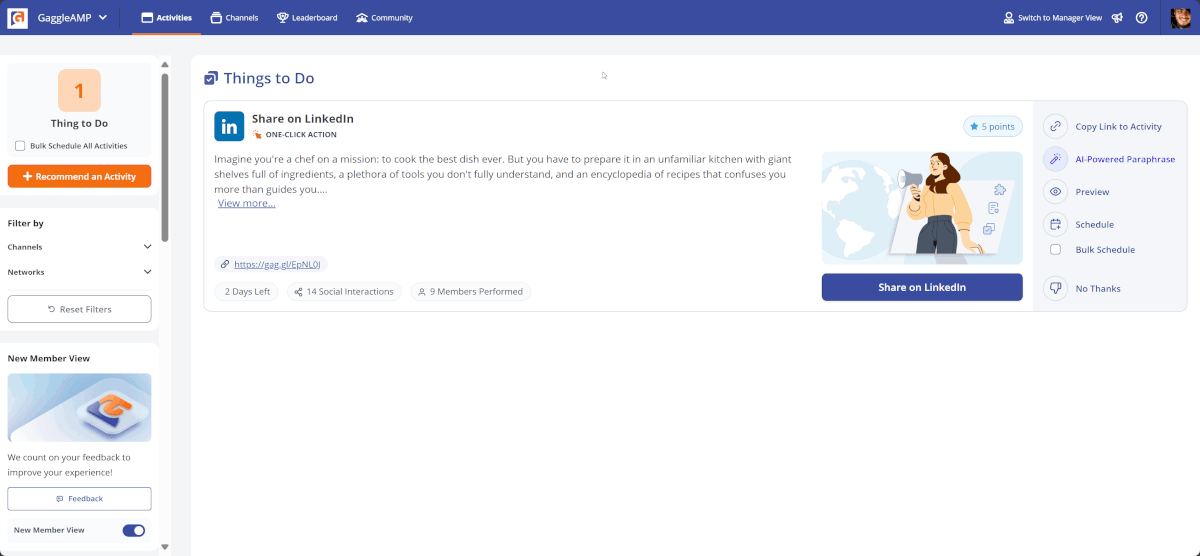
-
Curated Content: These platforms provide a selection of pre-approved company content, making it easy to find relevant material to share.
-
Scheduled Posting: Plan your content sharing in advance to maintain consistency.
-
Performance Metrics: Track the impact of your shares on both your personal network growth and company visibility.
There’s a wide range of content you can share, including but not limited to:
-
Company blog posts with your added insights.
-
Product launches or updates.
-
Industry reports or whitepapers.
-
Company culture highlights or behind-the-scenes glimpses.
-
Team achievements or professional milestones.
-
Company events or webinars.
Using LinkedIn Analytics
LinkedIn provides valuable analytics tools that track your profile's performance and content engagement. Use this data to inform decisions and refine your strategy when growing your network.
Key metrics worth tracking:
-
Post Views.
-
Post Impressions.
-
Engagement Rates (e.g., likes, comments, shares).
-
Profile Views.
-
Search Appearances.
-
Follower Growth.
Simple steps to act on these metrics:
-
Identify your top-performing posts and create similar content.
-
Understand which topics your audience is most interested in.
-
Note which days and times your posts get the most engagement.
-
Pay attention to the types of content (text, images, videos) that resonate most with your audience.
Maintaining Consistency
Based on your analytics, set specific, measurable goals. These will help drive consistency — the bedrock of a strong LinkedIn presence.
Goals can include anything from connecting with a certain number of people per week to posting a specific number of times per month. Scheduling LinkedIn activity will make your job easier and more effective, too.
-
Set aside dedicated time each day for LinkedIn activities.
-
Use tools like content calendars to plan your post creation process.
-
When completed, use LinkedIn’s scheduling feature to automatically publish posts on time.
-
Engage with your network's content daily (e.g., comment, like, share).
If you find that your engagement or reach is lacking, use LinkedIn’s analytics to identify areas for improvement and revise goals. Growing your LinkedIn network takes time and effort, but consistency is a proven way to get there.
Ready To Grow Your LinkedIn Network With GaggleAMP?
You cannot ignore the potential of your LinkedIn network — it’s a critical path to advancing your career and expanding your professional opportunities.
Your personal efforts go a long way, but leveraging the right tools can accelerate your networking success even further.
This is where GaggleAMP comes in.
As an industry-leading employee advocacy platform, GaggleAMP empowers you to share company content effortlessly, increasing both your visibility and your organization's reach.
Take the next step in your professional growth journey by exploring what GaggleAMP can do for you. Let your organization know what they’re missing, and start your free trial today!





